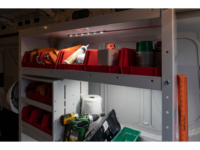
Photo courtesy of Outwater Plastics Industries Inc., Architectural Products by Outwater LLC
United States demand for molding and trim is forecast to exceed $10 billion in 2014 on annual increases of 10.0 percent. An expected rebound in new residential construction expenditures from their depressed 2009 level will fuel these gains. As the housing market contracted from 2006 through 2009, molding and trim demand suffered a steep decline. Even though the recovery in housing completions will still fall short of the 2004 level, new residential demand for molding and trim will have regained its usual share by 2014.
The close relationship between molding and trim sales and building construction makes patterns in construction activity the key indicator of demand for molding and trim. New construction expenditures have the most influence over demand. Installation of molding and trim products as part of new building projects, which typically accounts for more than 60 percent of overall demand, accounted for almost 54 percent of overall demand in 2009 despite a drastically weakened new residential market. The existing stock of buildings generates demand for molding and trim through improvement and repair projects. Such activities may include the replacement of products that have reached the end of their useful lifetime or the installation of new molding and trim as part of a project aimed at improving the appearance of a structure.
Residential Market
New residential construction typically accounts for more demand than any other market segment. From 2006 to 2009, however, the new residential market suffered extraordinary losses, dragging the overall molding and trim industry down with it. During that period, sales of new residential molding and trim fell below demand in both the residential improvement and repair and the new nonresidential markets. Going forward, an expected rebound in new residential construction will boost overall molding and trim demand. New residential molding and trim demand is forecast to increase rapidly through 2014 to $4.4 billion. Gains for molding and trim used in residential improvement and repair are expected to be more muted.
Nonresidential Market
Molding and trim demand derived from nonresidential construction is projected to expand at a modest pace through 2014 to $3.1 billion. Unlike the residential market, the market for nonresidential molding and trim continued to rise, albeit modestly, from 2006 to 2009. As a result, nonresidential molding and trim demand will not see the high growth rates predicted for the residential market through 2014. Within the nonresidential market, new construction accounts for the vast majority of demand. New nonresidential demand for molding and trim is forecast to increase to $2.3 billion by 2014. Nonresidential improvement and repair, traditionally the smallest market for molding and trim, is expected to remain relatively flat through 2014.Interior and Exterior Products
Despite competition from plastics and wood-plastic composites, wood will remain the leading material for molding and trim, with gains supported by the recovery in residential building construction. Solid price gains for wood will further boost market value. By 2014, plastic is forecast to surpass metal as the second leading material for molding and trim. Demand for plastic products will benefit from the rebounding new residential construction market, especially for exterior trim. Plastic products perform better than wood against exposure to the elements, thus making plastic an ideal choice for exterior molding and trim products. Further, improvements in the appearance of plastic have made high-end plastic molding almost indistinguishable to the untrained eye from wood molding.Interior molding accounts for the largest share of molding and trim demand. Because interior molding is widely used in all major types of housing, demand for these products will receive a major boost from the anticipated rebound in new residential construction. Value gains will be slightly faster, however, for exterior trim, aided in part by demand for higher-priced, more durable materials such as plastic.
Other Segments
Stairwork was the second largest product segment in 2009 behind moldings. Unlike moldings and other products, which derive a large majority of demand from residential construction, stairwork demand is evenly divided between residential and nonresidential applications. Through 2014, demand for stairwork will see solid gains despite the slow growth predicted in the nonresidential market. A spike in demand for new residential stairwork will counteract the softness in the nonresidential market and decrease the cost of the raw metals used most often in nonresidential stairwork.The other products segment will grow at the fastest pace through 2014. The other molding and trim products segment includes shutters, exterior trim, porch railing and components, decorative columns and fireplace surrounds, etc. Growth in other molding and trim demand is forecast to outpace growth in molding and stairwork demand, expanding a little over 11 percent per annum through 2014 to $2.8 billion.
The U.S. molding and trim industry encompasses thousands of firms involved in the manufacture and distribution of a broad range of molding and trim products. Because molding and trim products made from different raw materials require different manufacturing technologies, a majority of molding and trim firms are involved in the manufacture of products made from only one material type. The type of companies involved in each material segment, though, remains fairly similar. Most segments encompass firms ranging from small, single-location establishments to large building product concerns that offer a complete line of products for virtually any market.




Report Abusive Comment